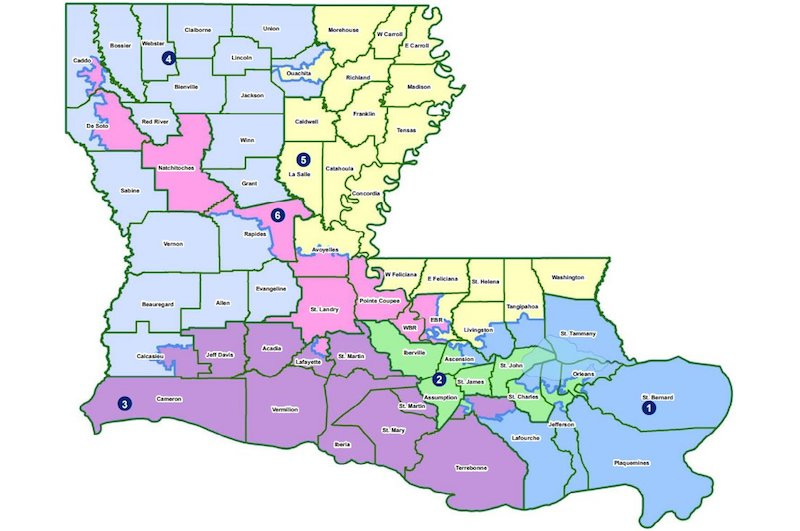Louisiana Approves New Congressional Map Featuring Two Majority-Black Districts
Republican Garrett Graves' 6th District was transformed to comply with the federal court order.
Earlier today, Louisiana Governor Jeff Landry, a Republican, signed into law new district lines for the state’s congressional delegation to the U.S. House of Representatives. The state legislature faced a January 30 deadline by a federal judge to redraw the map to allow Black voters to elect their candidate of choice in two of the state’s six districts. If the state legislature refused to comply, then the case would have gone to trial to select a new map in February. Instead, the new map passed through the state legislature last week.
Litigation over Louisiana’s congressional districts has been ongoing since 2022 - when the lines were updated following the 2020 census. At the time, the six districts only saw minimal adjustments for population growth. Then-Governor John Bel Edwards, a Democrat, vetoed those maps because they only created one Black-opportunity district. He argued the state should have two Black-majority districts as the Black voting age population in the state is 33%. The Republican-controlled state legislature ultimately overrode his veto. As such, the delegation continued to elect 5 White Republicans and 1 Black Democrat.
The plaintiffs in the lawsuit made the same argument in federal court. The implementation of new lines was, however, successfully delayed as the verdict was appealed on several different grounds. Moreover, the state legislature was still given the opportunity to redraw the lines themselves. As such, they easily could have operated like Georgia and Alabama last year by complying in a way that wouldn’t have changed the partisan balance of the congressional delegation. Instead, Louisiana Republicans seem to have complied with the court ruling in order to dictate which of the incumbents would lose their seat.
The previous version of the map included one Black-majority district - the 2nd (in green in the above map) - which stretched from New Orleans to several neighborhoods in Baton Rouge. The new lines will keep the 2nd District based in New Orleans with a safe Black majority. Democrat Troy Carter has represented the seat since May 2021. Meanwhile, the new Black opportunity district was created in the 6th (in pink above). It will stretch nearly 250 miles to connect the Black neighborhoods in Baton Rouge with the Black neighborhoods in Shreveport while also taking in the cities of Alexandria and Lafayette.
The previous 6th District covered the suburbs of Baton Rouge and continued south to Thibodaux and west to the shores of Lake Pontchartrian. The safe Republican district has been represented by Garret Graves since January 2015. He was apparently targeted in the redistricting process due to previous tension with Landry.
In early 2023, Graves spent months teasing a potential campaign for the open seat Governor’s race. That came while Landry was quickly consolidating Republican support throughout the state. Graves opted against the race but instead recruited Stephen Waguespack, who was the then-leader of the state’s Chamber of Commerce affiliate. Landry ultimately beat Democrat Shawn Wilson by a massive 52-26 margin last October, with Waguespack far back in third with only 6%.
In order to bring litigation arguing for the creation of a new minority-majority district, plaintiffs have to file several different maps showing how easily it can be done. However, those examples don’t have to be implemented by either the federal courts or the state legislature. In fact, Louisiana Republicans opted for their own creation. That decision ultimately split several counties to achieve the desired outcome unlike the plaintiffs’ maps which aimed to keep as many counties whole as possible.
The plaintiffs preferred transforming the state’s 5th District (in yellow above) to a Black majority. The district currently stretches from rural northeastern counties to several central cities as well as the northern parts of the Florida parishes. The district has been represented by Republican Julia Letlow since April 2021. She is currently the only woman in the state’s delegation to Congress. Graves could theoretically challenge her to represent the new 5th district - which covers some territory familiar to him. However, Letlow still covers the bulk of the new district. Plaintiffs could also file a legal challenge to the new districts. However, no one has yet suggested any official legal objections to what the state legislature has done.
Speaker of the House Mike Johnson comes from Louisiana’s 4th District (in pale blue above). Over the last week, he was upset the state legislature was complying with the court order. He didn’t want the delegation to surrender partisan control of one seat given how slim the current majority is for Republicans in the House. Despite that, the new 6th District is expected to safely elect a Black Democrat in this fall’s general election.
No candidates have yet announced their campaigns to represent the new 6th District. Under the new lines, the district would have favored Joe Biden by a 59-39 margin against Donald Trump in the 2020 presidential election. Potential Democratic candidates include former U.S. Representative and current State Senator Cleo Fields, 2022 Senate runner-up Gary Chambers, and Public Service Commissioner Davante Lewis. None of them have made any public comments on the race yet.


